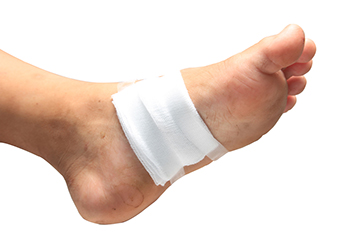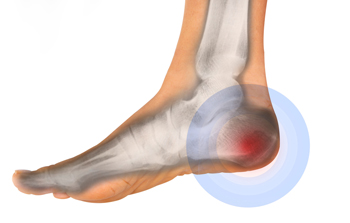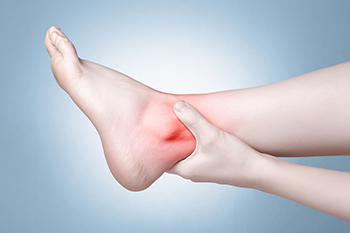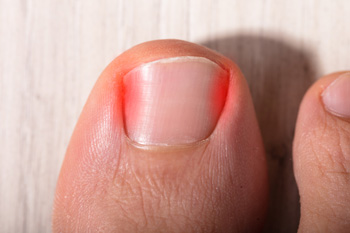Items filtered by date: January 2024
Diagnosis and Treatment of Achilles Tendon Injuries

The Achilles tendon, the body's largest and strongest tendon, is susceptible to injury due to its limited blood supply and exposure to various forces. Aging and increased activity, particularly in high-velocity sports, raise the risk of Achilles tendon injuries. As the aging population remains active, these conditions are becoming more common, yet they are missed in approximately one-fourth of cases. Injuries can happen suddenly or develop gradually, often leading to extended healing processes. To make an accurate diagnosis and establish an effective treatment plan, a comprehensive medical history and specific physical examination are critical. The primary approach to managing tendonitis, peritendonitis, tendinosis, and retrocalcaneobursitis involves rest, cold therapy, anti-inflammatory medications, and orthotics. Tendon ruptures require casting or surgical intervention. Adequate treatment typically results in a complete recovery. If you have a painful Achilles tendon, it is suggested that you schedule an appointment with a podiatrist for a proper evaluation and treatment options.
Achilles tendon injuries need immediate attention to avoid future complications. If you have any concerns, contact one of our podiatrists of Florida Family Podiatry. Our doctors can provide the care you need to keep you pain-free and on your feet.
What Is the Achilles Tendon?
The Achilles tendon is a tendon that connects the lower leg muscles and calf to the heel of the foot. It is the strongest tendon in the human body and is essential for making movement possible. Because this tendon is such an integral part of the body, any injuries to it can create immense difficulties and should immediately be presented to a doctor.
What Are the Symptoms of an Achilles Tendon Injury?
There are various types of injuries that can affect the Achilles tendon. The two most common injuries are Achilles tendinitis and ruptures of the tendon.
Achilles Tendinitis Symptoms
- Inflammation
- Dull to severe pain
- Increased blood flow to the tendon
- Thickening of the tendon
Rupture Symptoms
- Extreme pain and swelling in the foot
- Total immobility
Treatment and Prevention
Achilles tendon injuries are diagnosed by a thorough physical evaluation, which can include an MRI. Treatment involves rest, physical therapy, and in some cases, surgery. However, various preventative measures can be taken to avoid these injuries, such as:
- Thorough stretching of the tendon before and after exercise
- Strengthening exercises like calf raises, squats, leg curls, leg extensions, leg raises, lunges, and leg presses
If you have any questions please feel free to contact our offices located in Delray Beach and Boynton Beach, FL. . We offer the newest diagnostic tools and technology to treat your foot and ankle needs.
Do You Suffer From Painful Feet?
Managing Slow Healing Wounds

Living with diabetes brings its own set of challenges, and one significant concern is the potential for slow-healing wounds. While minor injuries are a part of life, individuals with diabetes face heightened risks. Wounds that linger, fail to heal, or become infected can lead to severe health issues, with infections spreading to nearby tissues or even becoming life or limb threatening. Monitoring these wounds is imperative as slow healing is not normal. Any signs of spreading, oozing, or extreme pain should not be ignored. Daily wound care, including cleaning and bandaging, is essential for prevention. For those with foot wounds, wearing shoes and socks may help to minimize infection risks, especially during physical activities, like walking. Seeking prompt medical attention for non healing foot wounds is paramount. Antibiotics may be necessary, and in severe cases, hospitalization may be required. This proactive approach to wound care, rooted in vigilant monitoring and early intervention, helps to guard against the potential complications of untreated wounds. If you notice lower leg and foot wounds that are slow in healing, it is suggested that you schedule an immediate appointment with a podiatrist who is trained in treating and managing foot wounds.
Wound care is an important part in dealing with diabetes. If you have diabetes and a foot wound or would like more information about wound care for diabetics, consult with one of our podiatrists from Florida Family Podiatry. Our doctors will assess your condition and provide you with quality foot and ankle treatment.
What Is Wound Care?
Wound care is the practice of taking proper care of a wound. This can range from the smallest to the largest of wounds. While everyone can benefit from proper wound care, it is much more important for diabetics. Diabetics often suffer from poor blood circulation which causes wounds to heal much slower than they would in a non-diabetic.
What Is the Importance of Wound Care?
While it may not seem apparent with small ulcers on the foot, for diabetics, any size ulcer can become infected. Diabetics often also suffer from neuropathy, or nerve loss. This means they might not even feel when they have an ulcer on their foot. If the wound becomes severely infected, amputation may be necessary. Therefore, it is of the upmost importance to properly care for any and all foot wounds.
How to Care for Wounds
The best way to care for foot wounds is to prevent them. For diabetics, this means daily inspections of the feet for any signs of abnormalities or ulcers. It is also recommended to see a podiatrist several times a year for a foot inspection. If you do have an ulcer, run the wound under water to clear dirt from the wound; then apply antibiotic ointment to the wound and cover with a bandage. Bandages should be changed daily and keeping pressure off the wound is smart. It is advised to see a podiatrist, who can keep an eye on it.
If you have any questions, please feel free to contact our offices located in Delray Beach and Boynton Beach, FL. . We offer the newest diagnostic and treatment technologies for all your foot care needs.
Common Culprits of Heel Pain

Heel pain, a pervasive issue affecting individuals across age groups, can stem from various causes, warranting a closer examination of the contributing factors. Plantar fasciitis, a prevalent cause, results from inflammation of the plantar fascia, which is the band of tissue connecting the heel bone to the toes. This condition is often aggravated by prolonged standing, excessive physical activity, or inadequate footwear. Achilles tendonitis, an inflammation of the Achilles tendon, can also manifest as heel pain, especially among athletes or those engaged in rigorous exercise. Heel spurs, bony protrusions at the base of the heel, may contribute to discomfort, often associated with conditions like plantar fasciitis. Additionally, bursitis or stress fractures in the heel region can give rise to persistent pain. Identifying the specific cause of heel pain is imperative for effective management. Heel pain for any reason can be treated by a podiatrist. If you are experiencing heel pain, it is strongly suggested that you visit this type of doctor who can provide you with effective treatment solutions.
Many people suffer from bouts of heel pain. For more information, contact one of our podiatrists of Florida Family Podiatry. Our doctors can provide the care you need to keep you pain-free and on your feet.
Causes of Heel Pain
Heel pain is often associated with plantar fasciitis. The plantar fascia is a band of tissues that extends along the bottom of the foot. A rip or tear in this ligament can cause inflammation of the tissue.
Achilles tendonitis is another cause of heel pain. Inflammation of the Achilles tendon will cause pain from fractures and muscle tearing. Lack of flexibility is also another symptom.
Heel spurs are another cause of pain. When the tissues of the plantar fascia undergo a great deal of stress, it can lead to ligament separation from the heel bone, causing heel spurs.
Why Might Heel Pain Occur?
- Wearing ill-fitting shoes
- Wearing non-supportive shoes
- Weight change
- Excessive running
Treatments
Heel pain should be treated as soon as possible for immediate results. Keeping your feet in a stress-free environment will help. If you suffer from Achilles tendonitis or plantar fasciitis, applying ice will reduce the swelling. Stretching before an exercise like running will help the muscles. Using all these tips will help make heel pain a condition of the past.
If you have any questions please contact our offices located in Delray Beach and Boynton Beach, FL. . We offer the newest diagnostic and treatment technologies for all your foot and ankle needs.
Types and Causes of Tarsal Coalition

Tarsal coalition, which affects approximately one in every 100 people, emerges during adolescence, causing pain and stiffness in the foot. The issue arises when certain tarsal bones fuse or abnormally connect. This leads to a rigid and inflexible region that includes the talus, calcaneus, cuboid, navicular, and cuneiform bones of the foot. The most common types are calcaneonavicular and talocalcaneal coalition, where bridges form between the calcaneus and navicular bones, or between the calcaneus and talus. Three categories of tarsal coalition are osseus coalition, which involves bony growth, cartilaginous coalition which affects cartilage growth, and fibrous coalition which consists of fibrous tissue growth. Causes of tarsal coalition include genetic abnormalities and foot trauma, such as fractures or sprains, which can disrupt connective tissue development. This may lead to abnormal growth and fusion. Infections that weaken foot structures may cause inflammation, further disrupting normal tissue development. Arthritis, especially certain types and associated medications, increase the risk of abnormal growth and fusion in the foot. Understanding the types and causes is important for early diagnosis and tailored treatment plans. For those experiencing persistent foot pain or suspecting tarsal coalition, it is suggested that you schedule an appointment with a podiatrist for an accurate diagnosis and effective management.
Some foot conditions may require additional professional care. If you have any concerns, contact one of our podiatrists of Florida Family Podiatry. Our doctors can provide the care you need to keep you pain-free and on your feet.
Rare Foot Conditions
The majority of foot conditions are common and can be treated by a podiatrist. Standard diagnostic procedures are generally used to identify specific conditions and treatment can be rendered. A podiatrist also treats rare foot conditions which can be difficult to diagnose and may need extra attention and care.
There are many rare foot conditions that can affect children. Some of these can include:
- Freiberg’s disease
- Kohler’s disease
- Maffucci syndrome
Freiberg’s disease - This can be seen as a deterioration and flattening of a metatarsal bone that exists in the ball of the foot. It typically affects pre-teen and teenage girls, but can affect anyone at any age. Symptoms that can accompany this can be swelling, stiffness, and the patient may limp.
Kohler’s disease - This often targets the bone in the arch of the foot and affects younger boys. It can lead to an interruption of the blood supply which ultimately can lead to bone deterioration. The patient may limp or experience tenderness, swelling, and redness.
Maffucci syndrome - This affects the long bones in a child’s foot leading to the development of abnormal bone lesions. They are benign growths and typically develop in early childhood and the bones may be susceptible to breaking.
A podiatrist can properly diagnose and treat all types of rare foot conditions. If your child is affected by any of these symptoms or conditions, please don’t hesitate to call our office so the correct treatment method can begin.
If you have any questions please feel free to contact our offices located in Delray Beach and Boynton Beach, FL. . We offer the newest diagnostic tools and technology to treat your foot and ankle needs.
Ingrown Toenails and Their Causes

Ingrown toenails, a source of persistent discomfort, unfold as a condition where, instead of growing over the skin, the toenail curves and pierces the surrounding flesh. This occurrence often results in tenderness, redness, and swelling, creating an environment conducive to pain and potential infection. The causes of ingrown toenails are diverse, with improper nail trimming ranking among the primary culprits. Cutting the nails too short or rounding them excessively can encourage ingrowth. Wearing ill-fitting footwear, particularly shoes that crowd the toes, exerts pressure on the toenails and exacerbates the risk of ingrowth. Trauma or injury to the toe, such as stubbing, may also distort nail growth patterns. Genetic predispositions, where individuals inherit a tendency for irregular toenail growth, can contribute to this condition. If you have developed an ingrown toenail, it is strongly suggested that you consult a podiatrist in a timely manner so the correct treatment can begin.
Ingrown toenails may initially present themselves as a minor discomfort, but they may progress into an infection in the skin without proper treatment. For more information about ingrown toenails, contact one of our podiatrists of Florida Family Podiatry. Our doctors can provide the care you need to keep you pain-free and on your feet.
Ingrown Toenails
Ingrown toenails are caused when the corner or side of a toenail grows into the soft flesh surrounding it. They often result in redness, swelling, pain, and in some cases, infection. This condition typically affects the big toe and may recur if it is not treated properly.
Causes
- Improper toenail trimming
- Genetics
- Improper shoe fitting
- Injury from pedicures or nail picking
- Abnormal gait
- Poor hygiene
You are more likely to develop an ingrown toenail if you are obese, have diabetes, arthritis, or have any fungal infection in your nails. Additionally, people who have foot or toe deformities are at a higher risk of developing an ingrown toenail.
Symptoms
Some symptoms of ingrown toenails are redness, swelling, and pain. In rare cases, there may be a yellowish drainage coming from the nail.
Treatment
Ignoring an ingrown toenail can have serious complications. Infections of the nail border can progress to a deeper soft-tissue infection, which can then turn into a bone infection. You should always speak with your podiatrist if you suspect you have an ingrown toenail, especially if you have diabetes or poor circulation.
If you have any questions, please feel free to contact our offices located in Delray Beach and Boynton Beach, FL. . We offer the newest diagnostic and treatment technologies for all your foot care needs.




